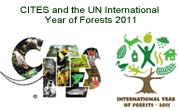
Long-tailed macaque used in biomedical research, sturgeons, seahorses and
shark-fishing regulations also under review - The 25th meeting of the Animals Committee of the Convention on International Trade in Endangered Species of Wild Fauna and Flora (CITES) concluded with key scientific findings for the conservation and sustainable use of several reptiles, marine species and amphibians. A record number of over 200 delegates, from fifty countries, attending the meeting expressed concern about the sustainability of current levels of trade in skins of three species of snakes used in luxury products and an other 20 animal species used in biomedical research, the food industry or as pets. (From Press Statement)
Snakes:
The Committee examined recent recorded trade in three snake species originated in South-east Asia: Ptyas mucosus (Oriental rat snake), Python reticulatus (Reticulated python) and Naja sputatrix (Indonesian cobra). Snakes from the forests and jungles of Asia play a vital role within their ecosystems. For example, if snakes were to disappear from the rice fields or other crop-producing landscapes of Asia, their prey, left behind with no predator to control their numbers, could have devastating effects on agricultural production, food security and national economies. Snakes are consumed for food, traditional medicines and skins. They are also sold as pets and found in expensive luxury leather goods and accessories, in the boutiques of Europe and North America. Their skins are often processed in various countries of re-export along the way.
Macaque:
The Committee also examined volumes of international trade in the long-tailed macaque (Macaca fascicularis) used in biomedical research and originating mainly in China, Indonesia and Cambodia. This macaque has experienced a rapid surge in international trade since 2004 (see figure on the left) and of all the mammals listed in the CITES Appendices is the species most traded in live form.
Southeast Asia “Hotspot”:
Mr Carlos Ibero, Chair of the Animals Committee, declared that “many of the individual species that have been reviewed and considered at this meeting occur in Southeast Asia, which has become a sort of hotspot for wildlife trade”. “This is due to the fact that it is a region rich in biodiversity with an increasing prosperous population as well as many people relying on wildlife for their living”, he added.
Sturgeons – Caspian Sea”:
The Committee also reviewed stock assessment methodologies for sturgeons and paddlefish in the Caspian Sea, a group of fish in high demand for their eggs (sold as caviar). Several range States present at the meeting announced a moratorium on wild sturgeon fishing for 2011, including Azerbaijan and Iran. The Committee recognized the insufficient sturgeon stock assessment expertise in the region as a major impediment to the progress in implementing previous recommendations and requested CITES, FAO and other international organizations to provide financial and technical support for the implementation of a three-phase work-plan focused on stock-assessment activities, including training and capacity building.
Sharks:
CITES experts also remain concerned about the status of sharks and requested the CITES Secretariat to collaborate closely with the FAO Secretariat in the review of the implementation of the International Plan of Action for the Conservation and Management of Sharks (IPOA-Sharks) requested by the FAO Committee on Fisheries (COFI), in particular the inclusion of trade information and the review of shark regulations adopted by Regional Fishery Management Organizations (RFMOs), including stock assessments, ecological risk assessments, conservation and management measures.
Madagascar:
Several endemic species from Madagascar, including chameleons and frogs, and seahorses from Southeast Asia, were also identified as a priority under the CITES Review of Significant Trade.
Hunting Falcons:
The Animals Committee finally recognized the progress made in the conservation of the saker falcon (Falco cherrug) in Mongolia and endorsed the positive management regime for this species used for hunting activities in the Middle East. The Committee agreed to Mongolia’s proposed export quota of 300 live specimens for 2011.
Science at Core of Diplomatic Work:
In closing the meeting, CITES Secretary-General, John E Scanlon, highlighted that: “sound science goes to the core of the Convention, and thanked the Animals Committee and all Observers for the time and expertise they volunteer to the work of the Convention”. “The work of the Committee over the past five days again highlights the very operational and pragmatic nature of CITES in addressing ‘real world’, on-the-ground conservation and sustainable use challenges” said Scanlon.
The CITES Animal Committee provides the technical and scientific basis for the sustainability of international trade in live specimens, parts and derivatives from over 4,500 species of animals.
By Ambassador Muhamed Sacirbey
Facebook Become a Fan – “Diplomatically Incorrect”
Twitter Follow us - DiplomaticallyX
More at Ecology-Diplomat -
diplomaticallyincorrect.org/c/ecology-diplomat/most_recent/1

